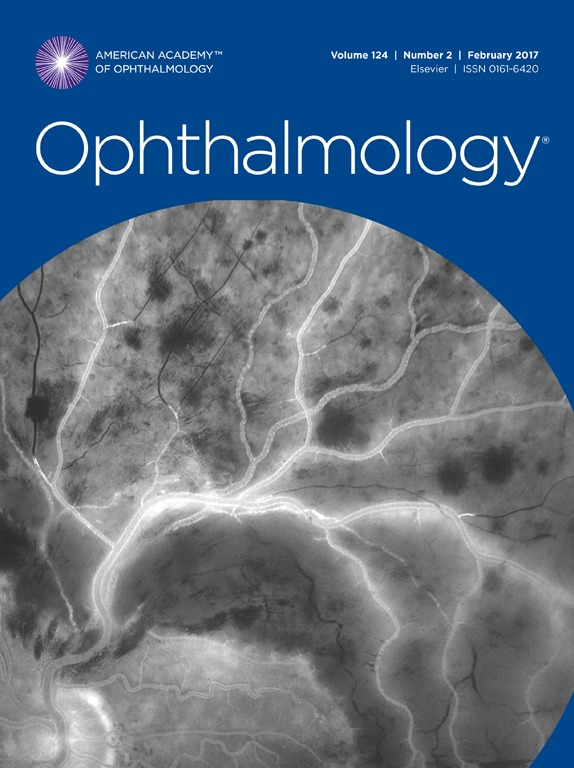自述视力困难与客观视力损伤之间的一致性:全国健康与老龄化趋势研究》。
IF 9.5
1区 医学
Q1 OPHTHALMOLOGY
引用次数: 0
摘要
目的研究自我报告的视觉困难(VD)在预测老年人客观视觉损伤(VI)方面的表现,并探讨影响这些分类不一致的因素:方法:对全国健康与老龄化趋势研究(2022 年)进行横断面分析:方法:将报告失明或远近视力有困难的参与者定性为视力障碍者。对参与者的双眼远视力 (VA)、近视力 (VA) 和对比敏感度 (CS) 进行评估。客观视力障碍的定义是远视力(低于 20/40)、近视力(低于 20/40)或对比敏感度(低于 1.55 logCS)均为视力障碍。接收者操作特征分析用于比较 VD 在预测客观 VI 方面的性能。为了研究影响不一致的因素,我们将样本限定为具有客观视力障碍的成年人,并采用多变量逻辑回归模型来确定与未报告 VD 相关的因素。我们还进行了类似的分析,以探讨与没有客观VI的成年人报告VD相关的因素:2022 年的队列中有 4999 名成人。VD预测客观VI的曲线下面积(AUC)为56.0(95% CI:55.2,56.9),灵敏度为15.8(95% CI:14.2,17.5),特异性为96.3(95% CI:95.5,96.9)。与客观 VI 成人未报告 VD 相关的特征包括:女性(几率比 [OR]:0.64 [95% CI:0.42, 0.99])、西班牙裔(OR:0.49 [95% CI:0.31,0.78)、收入较高(≥75k,OR:1.99 [95% CI:1.14,3.45])、合并症≥4 种(OR:0.46 [95% CI:0.29,0.72])和有抑郁症状(OR:0.49 [95% CI:0.25,0.93])。同时,在没有客观视力障碍的情况下,与自我报告视力障碍相关的因素包括西班牙裔(OR:2.11 [95% CI:1.15, 3.86])、高收入(≥75k,OR:0.27 [95% CI:0.12, 0.63])和焦虑症状(OR:3.05 [95% CI:1.56, 5.97]):自我报告的视觉困难是评估残疾的一种独特方法,在预测客观 VI 方面能力有限。在流行病学研究中,将自我报告的视觉困难作为客观VI的替代测量指标时应谨慎,尽管它仍可能是捕捉当前或未来残疾风险的有效方法。本文章由计算机程序翻译,如有差异,请以英文原文为准。
Concordance between Self-Reported Visual Difficulty and Objective Visual Impairment
Purpose
To examine the performance of self-reported visual difficulty (VD) in predicting objective visual impairment (VI) in older adults and explore factors that influence discordance.
Design
Cross-sectional analysis of the National Health and Aging Trends Study (2022).
Methods
Participants reporting blindness or difficulties with distance or near vision were characterized as having VD. Presenting binocular distance visual acuity (VA), near VA, and contrast sensitivity (CS) were assessed. Objective VI was defined as having VI in distance VA (worse than 20/40), near VA (worse than 20/40), or CS (worse than 1.55 logCS). Receiver operating characteristic analysis was used to compare performance of VD in predicting VI. To investigate factors that influence discordance, we limited our sample to adults with VI and used a multivariable logistic regression model to identify factors associated with not reporting VD. Similar analyses were performed to explore factors associated with reporting VD in adults without VI.
Main Outcome Measures
Discordance factors.
Results
Four thousand nine hundred ninety-nine adults were included in the 2022 cohort. Visual difficulty achieved an area under the curve (AUC) of 56.0 (95% confidence interval [CI], 55.2–56.9) in predicting VI, with a sensitivity of 15.8 (95% CI, 14.2–17.5) and specificity of 96.3 (95% CI, 95.5–96.9). Characteristics associated with not reporting VD in adults with VI included female gender (odds ratio [OR], 0.64 [95% CI, 0.42–0.99]), Hispanic ethnicity (OR, 0.49 [95% CI, 0.31–0.78), higher income (≥75 000, OR, 1.99 [95% CI, 1.14–3.45]), ≥4 comorbidities (OR, 0.46 [95% CI, 0.29–0.72]), and depressive symptoms (OR, 0.49 [95% CI, 0.25–0.93]). Factors associated with self-reporting VD in the absence of VI included Hispanic ethnicity (OR, 2.11 [95% CI, 1.15–3.86]), higher income (≥$75 000, OR, 0.27 [95% CI, 0.12–0.63]), and anxiety symptoms (OR, 3.05 [95% CI, 1.56–5.97]).
Conclusions
Self-reported VD is a distinct measure assessing disability and has limited ability in predicting objective VI. Caution is advised when using self-reported VD as a surrogate measure for objective VI in epidemiological studies, although it may still be an effective way to capture risk of current or future disability.
Financial Disclosure(s)
Proprietary or commercial disclosure may be found after the references.
求助全文
通过发布文献求助,成功后即可免费获取论文全文。
去求助
来源期刊

Ophthalmology
医学-眼科学
CiteScore
22.30
自引率
3.60%
发文量
412
审稿时长
18 days
期刊介绍:
The journal Ophthalmology, from the American Academy of Ophthalmology, contributes to society by publishing research in clinical and basic science related to vision.It upholds excellence through unbiased peer-review, fostering innovation, promoting discovery, and encouraging lifelong learning.
 求助内容:
求助内容: 应助结果提醒方式:
应助结果提醒方式:


